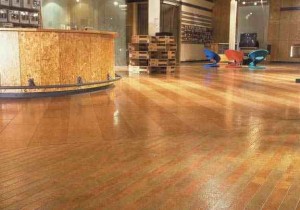
John Bleasby
Flooring options beyond hardwood (3)
Canadian ContractorCork has its many pro’s but some con’s. Care must be taken that it is used in appropriate locations.
Cork flooring has been going in and out of style for more than a century, increasing in popularity thanks to Frank Lloyd Wright, and peaking in the 1960s and ’70s. It burst back into favour about 15 years ago due to its retro appeal and sustainable nature.
Cork flooring is manufactured from scraps of bark left over from punched-out bottle stoppers that are ground, pressed and baked into sheets, and then converted into floor planks and tiles. Cork gets high marks for eco-friendliness both as a long-term renewable resource and as a strictly regulated process that minimises damage. Portugal accounts for more than half the world’s production.
The good news
Like a wine cork, cork flooring is springy and flexible. These characteristics make it a good choice for a kitchen, where it reduces the chances of broken glass, or in a home gym. Cork is warm underfoot, fire resistant and is great at muffling sound. Because cork doesn’t accrue dust and contains suberin, a natural substance that fends off mold, mildew, rot and pests, it’s ideal for allergy sufferers. From a fashion standpoint, cork is available is a wide range of rich textures and tones, even bold colours; looks that are unique and cannot be duplicated by other materials.
But is cork tough?
Cork is not ideal for every area of the home. While the pliable nature of cork allows it to bounce back from small nicks, certain day-to-day activities can result in hard-to-repair damage; sliding a table across the floor can take out a chunk of cork, heavy furniture can cause permanent dents, and colours can fade in sunlight. The potential for scuffing from pets must also to be considered.
Standing water must be avoided or joints can lift. Prior to installing cork in a bathroom, basement, laundry area or any area of dampness or high humidity, consult a specialist about how to ward off water leakage and infiltration.
Cork requires maintenance
Crumbs, dirt and other detritus can scar its surface over time if not swept or vacuumed regularly, making it a questionable choice for entrances or high traffic areas. Recommended cleaners must be used, and damp-mopping versus wet-mopping is important.
Cork should be re-sealed with protective coats of polyurethane every few years. Alternatively, wax sealants can be used, which are less likely to scratch but must be stripped and reapplied more frequently. Even pre-finished cork still will needs periodic maintenance.
Numerous installation options
Cork flooring comes in planks, tiles or sheets. Planks can either be glued-down as solid cork or installed as an engineered laminate (cork veneer with a fiberboard core). The “floating floor” locking type is easy to install, and ideal below grade over concrete, but should be avoided in moist areas, since the fibreboard underlay will likely warp. Solid cork tile require serious surface prep work and will result in visible seams, avoidable if either custom-cut shapes or rolled sheets are chosen. However, the possibility for creative patterns is almost unlimited. Hiring an experienced pro is recommended.
Other considerations
Cork costs less than most hardwoods, and about the same as quality bamboo. However, low density (ie. low priced) cork should be avoided. The material’s natural insulation qualities highlight a debate concerning radiant floor heating. Although there are no technical obstacles, some will argue that a cork floor is slow to warm up.
Cork will deliver a beautiful floor surface that can potentially last years, but must be selected wisely for the most appropriate locations.
Missed John’s previous ‘Beyond Hardwood’ installments? Catch up now.
Hardwood flooring: The current new floor favorite
Bamboo flooring: A serious rival to hardwood
Receive Canadian Contractor print edition….IT’S FREE….CLICK HERE
Advertisement
Print this page


Can cork be installed over ceramic tile floors? That would save tremendous cost and will minimize labour and disruption to the home considerably .
Hi George….You probably want to confirm this with a flooring pro, but I suspect that some surface prep would be required to level off the seams between the ceramic tile where the grout sits, in order to give you a truly level surface. Also be aware of the increased thickness of the floor and how it might impact cupboards, appliances, trim etc.